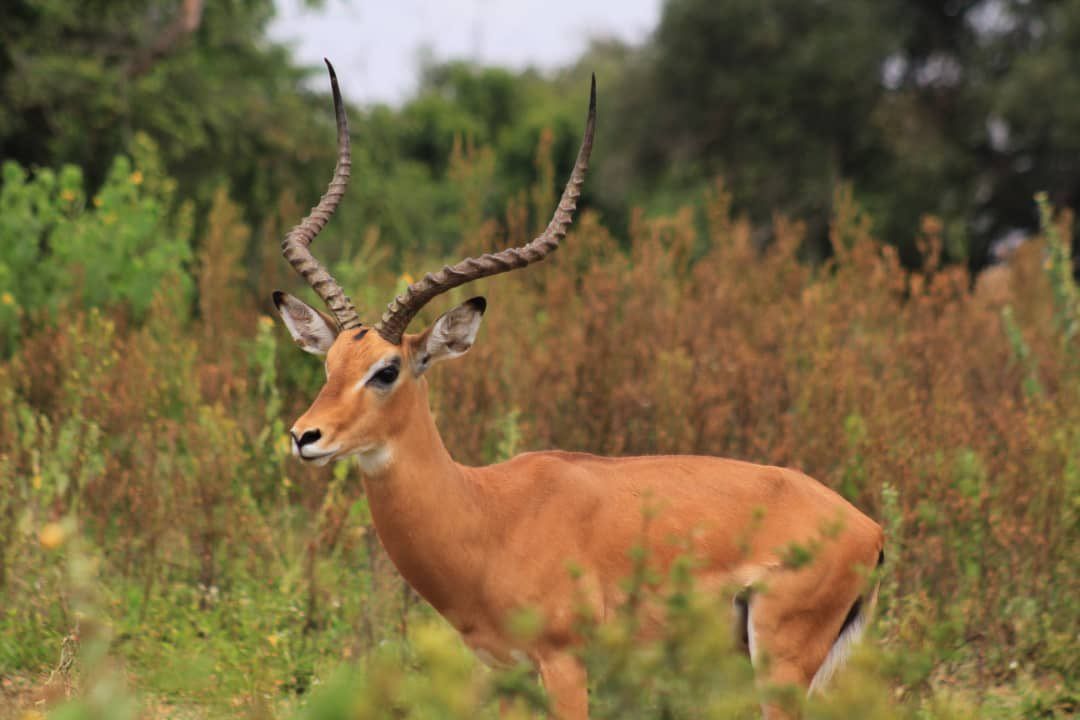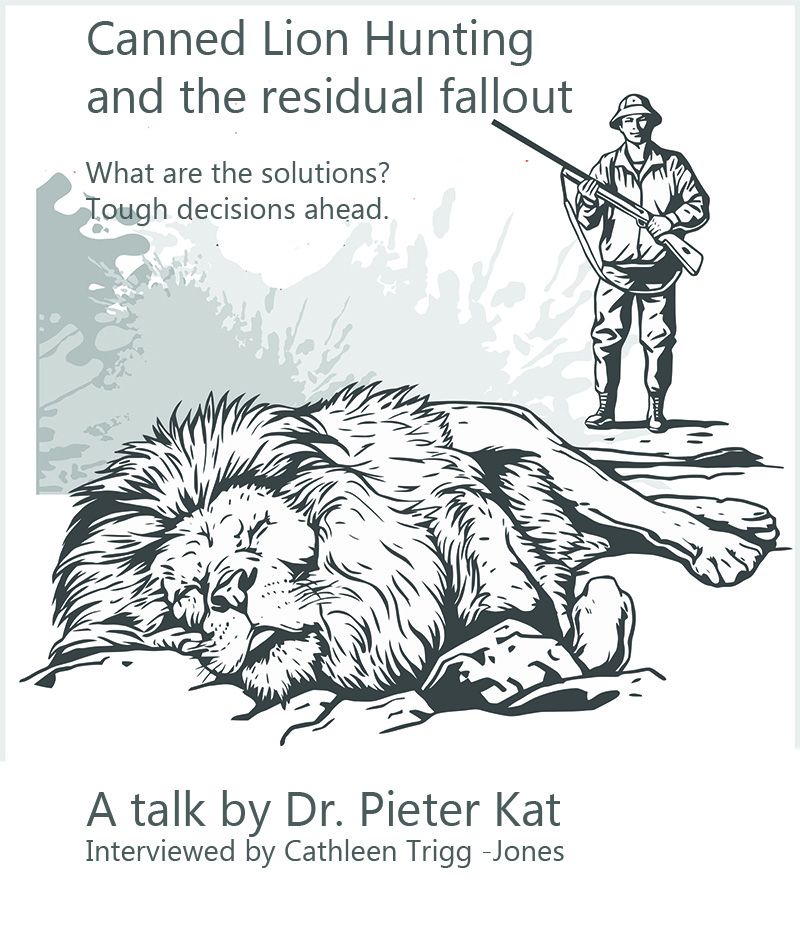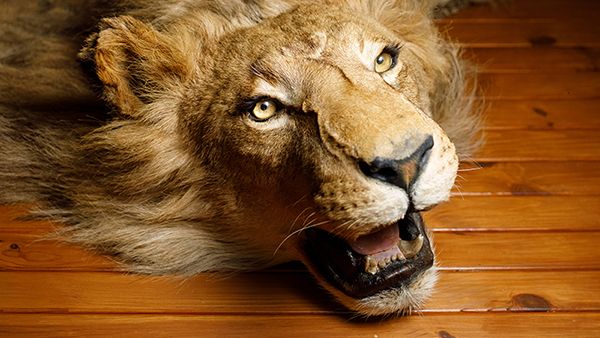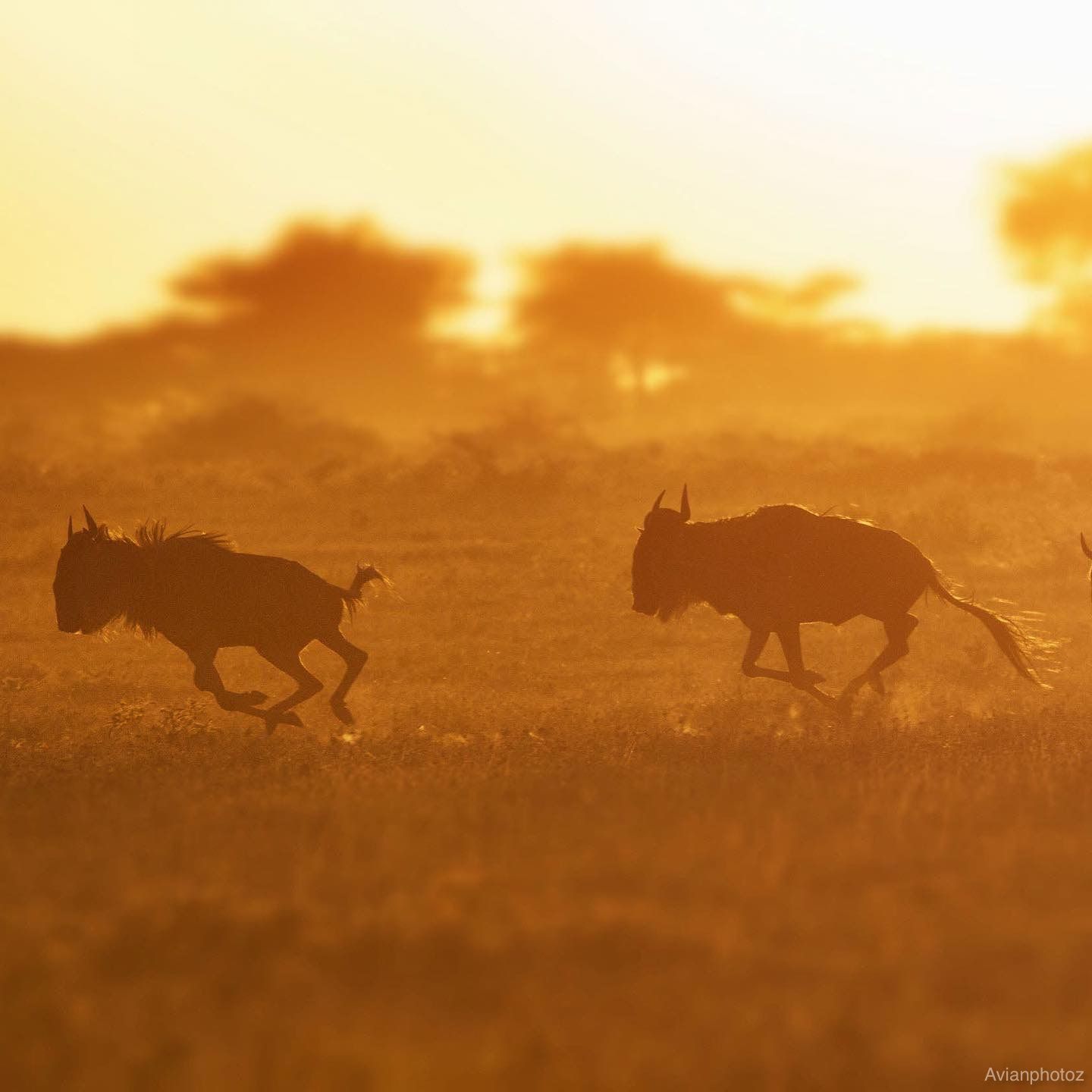 The Ugandan kob (Kobus kob thomasi), male,Queen Elizabeth NP, Uganda, 2016.
The Ugandan kob (Kobus kob thomasi), male,Queen Elizabeth NP, Uganda, 2016.
The Ugandan kob is a subspecies of the kob, a type of antelope. Only the males have horns, which are lyre-shaped, strongly ridged and divergent.
Males are slightly larger than females, being 90 to 100 cm (3.0 to 3.3 ft) at the shoulder, with an average weight of 94 kg (207 lb), while females are 82 to 92 cm (2.7 to 3.0 ft) at the shoulder and on average weigh about 63 kg (139 lb). Apart from the throat patch, muzzle, eye-ring and inner ear, which are white, the coat is golden to reddish-brown, the color differentiating it from other kob subspecies. The belly and inside of the legs are white, and the front of the forelegs are black.
It is typically found in open or wooded savanna, within a reasonable distance of water, and it also occurs in grasslands near rivers and lakes.
Ugandan kobs are herbivores and feed largely on grasses and reeds.
The females and young males form loose groups of varying size which range according to food availability, often moving along watercourses and grazing in valley bottoms. Sometimes non-breeding males form their own groups. Ugandan kobs usually have a lek mating system, in which males defend small territories clustered on traditional mating grounds. Females visit these leks only to breed, and males provide no parental care. Each lek is associated with a female herd of about 100 individuals. Females begin to mate at the age of one, but males must normally wait for several more years. A single calf is born in November or December, after a gestation period of about nine months.
Ugandan kob appears on the coat of arms of Uganda. #Godfreytheguide #Uganda #Animals #Antelope.
www.interiorsafarisea.com

Sign up for a free account with MojoStreaming and get free entrance to this Live - Streamed event.
Thursday March 25th 2021 at 2PM Eastern Standard Time, 6PM Greenwich Mean Time.
First 70 people to sign up will be admitted to the event
Great news to read that the House of Lords is to back the ban on trophy hunting imports into the UK (Saturday Mirror June 17th).

What planet is Crossbencher Lord St John of Bletso on?, who in his ignorance supports the bill, and comments “ Evidence shows properly regulated wild trophy hunting does play an important role in wildlife conservation”.
Certainly not in Zimbabwe M’Lord! – as a former Chief Inspector for the Zimbabwe National Soc. For the Prevention of Cruelty to Animals (ZNSPCA), I saw first hand how funding that was supposed to be given to the local communities where hunts took place, was rarely received by them.
Instead due to rampant corruption, it was the Town Councillors who were seen driving around in 4x4s and Mercedes, while the local villagers got nothing, except possibly some meat from the hunts.
In addition, some of the trophy hunters who visit Zimbabwe are also guilty of unethical practices, such as using donkeys and goats as live bait.
In addition, there are still several trophy hunters who are using packs of imported hounds to hunt Zimbabwean leopards which was illegal under Zimbabwe’s Wild Life Act.
I know because I was responsible for getting an Amendment to the Act making it illegal for hunters to use packs of dogs - only for the USA’s notorious Safari Club International to swiftly “persuade” the Zimbabwean Govt to make hunting with dogs “legal” again.
This practice is disliked by many professional hunters, who say that “the leopard does not stand a chance”, one Zimbabwean hunter who did use dogs for his clients, when questioned in an interview as to whether this method was ethical? - replied “it may be cruel”
Pro Trophy Hunting activists should be aware that several hunting safaris in Zimbabwe still offer this practice to their rich overseas clients, who pay extra if packs of dogs are used.
However, if a local Zimbabwean living in the rural areas, is caught hunting with his own indigenous dogs to catch rabbits and small animals to feed his family – the Zimbabwean Government’s Police shoot his dogs, he is arrested, taken to court and fined, with the possibility of being jailed if he has no money for the fine, which is more often the case............talk about double standards.
.
May I suggest that Lord St John of Bletso gets his facts right – trophy hunting is not the cosy “regulated “ pastime he seems to think it is?
Meryl Harrison
 Late October and early November see the last of the wildebeest river crossings before the herds begin to move to the edge of the short-grass plains in southern Serengeti for the unparalleled spectacle that is their birthing season. As the wildebeest empty out, so do the people, and these three months in the Mara before the festive season mark a spectacular time to roam and explore without the distraction of other vehicles and the millions-strong herds. The rest of the game comes to the fore, as does the cultural element in Serengeti South: the Hadzabe make for fascinating walking companions as they reveal their homeland to you on foot. This time of year yields itself to long lazy stays, with some adventure fly camping and safaris on foot thrown into the mix. http://interiorsafarisea.com/category/tanzania-safaris/
Late October and early November see the last of the wildebeest river crossings before the herds begin to move to the edge of the short-grass plains in southern Serengeti for the unparalleled spectacle that is their birthing season. As the wildebeest empty out, so do the people, and these three months in the Mara before the festive season mark a spectacular time to roam and explore without the distraction of other vehicles and the millions-strong herds. The rest of the game comes to the fore, as does the cultural element in Serengeti South: the Hadzabe make for fascinating walking companions as they reveal their homeland to you on foot. This time of year yields itself to long lazy stays, with some adventure fly camping and safaris on foot thrown into the mix. http://interiorsafarisea.com/category/tanzania-safaris/
Wildlife crime encompasses a range of illegal activities that threaten the survival of animal and plant species worldwide. At its core, it includes poaching, the illegal hunting or capturing of wildlife, and the illicit trade of their products. This crime not only targets endangered species but also affects ecosystems and biodiversity as a whole. Understanding the definition and scope of wildlife crime is crucial for nature lovers and activists who seek to protect the delicate balance of our natural world. The severity of wildlife crime is underscored by its connection to organized crime syndicates, which operate across borders, making it a global concern that transcends local and national jurisdictions.
Poaching poses one of the most significant threats to wildlife, particularly for endangered species like elephants, rhinos, and tigers. These animals are often hunted for their ivory, horns, or skins, which are sold for high prices in illegal markets. The demand for these products fuels a cycle of violence and destruction, as poachers often use sophisticated techniques and equipment to carry out their activities. The impact of poaching extends beyond the immediate loss of individual animals; it can destabilize entire ecosystems and disrupt food chains, leading to broader ecological repercussions. For wildlife enthusiasts, recognizing the signs of poaching and its consequences is essential for advocacy and conservation efforts.
Illegal wildlife trade networks operate on a global scale, facilitating the movement of poached animals and their parts. These networks exploit weaknesses in legal frameworks and enforcement mechanisms, often involving corrupt officials and dangerous criminal organizations. The trade in wildlife is not limited to charismatic megafauna; it also includes a wide range of species, from reptiles and birds to plants. The complexity of these networks makes it challenging for law enforcement agencies to combat wildlife crime effectively. Awareness of the intricacies of these trade routes is vital for activists who wish to dismantle such operations and promote sustainable practices.
The impact of wildlife crime on biodiversity cannot be overstated. As species are driven to extinction, the natural balance of ecosystems is disrupted, affecting not only wildlife but also human communities that rely on these ecosystems for their livelihoods. The loss of biodiversity can lead to diminished natural resources, increased human-wildlife conflicts, and reduced resilience to environmental changes. For nature lovers, the health of ecosystems is intertwined with their passion for wildlife, making it imperative to address the underlying causes of wildlife crime and advocate for stronger protections for both animals and their habitats.
Legislation and enforcement play critical roles in the fight against wildlife crime. Many countries have implemented laws aimed at protecting endangered species and regulating wildlife trade. However, the effectiveness of these laws often hinges on enforcement capabilities and international cooperation. Successful prosecutions of wildlife crime serve as powerful case studies that highlight the importance of accountability in deterring illegal activities. Engaging local communities in conservation efforts is another key strategy to combat wildlife crime, as these communities can be both victims and protectors of wildlife. By fostering a sense of stewardship and providing economic alternatives, it is possible to build a more sustainable future for both wildlife and people.
Understanding the historical context of wildlife crime is essential to grasp the significant challenges faced in the global fight against this pressing issue. For centuries, humans have exploited wildlife for various purposes, ranging from sustenance to ornamentation. The rise of the industrial age marked a pivotal moment, as demand surged for animal products like ivory, fur, and exotic pets. This exploitation was often fueled by colonial expansion, where resources were extracted with little regard for ecological consequences. As a result, many species faced severe population declines, prompting early conservation efforts in the late 19th and early 20th centuries, which laid the groundwork for modern wildlife protection laws.
As the 20th century progressed, wildlife crime evolved alongside changes in technology and commerce. The advent of global trade agreements and advancements in transportation made it easier for illegal wildlife products to cross borders. Organized crime syndicates began to recognize the lucrative potential of wildlife trafficking, leading to a dramatic increase in poaching, particularly of endangered species. Iconic animals like elephants and rhinoceroses became prime targets due to the high value of their tusks and horns. The illegal wildlife trade transformed from opportunistic poaching into a sophisticated, multi-billion-dollar industry, with complex networks operating across continents.
The impact of wildlife crime on biodiversity cannot be overstated. As species are driven to extinction due to poaching and habitat destruction, the ecological balance is disrupted, affecting entire ecosystems. This loss of biodiversity has far-reaching implications, from diminishing resilience against climate change to disrupting food webs. The decline of keystone species can trigger cascading effects, leading to the deterioration of habitats and the extinction of other flora and fauna. Recognizing these consequences has led to increased advocacy for stronger wildlife protection measures and greater awareness of the interconnectedness of species and ecosystems.
In response to the growing crisis, legislative frameworks have emerged to combat wildlife crime. International agreements such as the Convention on International Trade in Endangered Species of Wild Fauna and Flora (CITES) aim to regulate and monitor the trade of endangered species. Countries have also enacted national laws to strengthen enforcement against poaching and trafficking. Successful prosecutions of high-profile wildlife crime cases serve as pivotal moments that not only bring justice but also raise public awareness. These cases illustrate the importance of collaboration among governments, NGOs, and local communities in the fight against wildlife crime.
Community involvement has emerged as a critical component in the fight against wildlife crime. Local populations are often on the front lines, witnessing the effects of poaching and habitat loss firsthand. Empowering communities through education, alternative livelihoods, and participatory conservation initiatives has proven effective in reducing reliance on illegal wildlife trade. By fostering a sense of stewardship for local wildlife, communities can play a vital role in protecting their natural heritage. Additionally, understanding wildlife trafficking routes and hotspots is essential for targeted enforcement efforts, as these areas often indicate higher levels of illegal activity. Engaging local stakeholders in these efforts not only aids in conservation but also promotes sustainable development, aligning the interests of both wildlife and people.
Cami Ciotta
MojoStreaming
Creator of an upcoming TV Series on Wildlife Crime - If you would like to learn more contact Cami at producer@wildlifecrimeseries.com